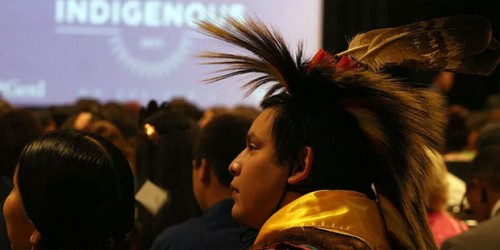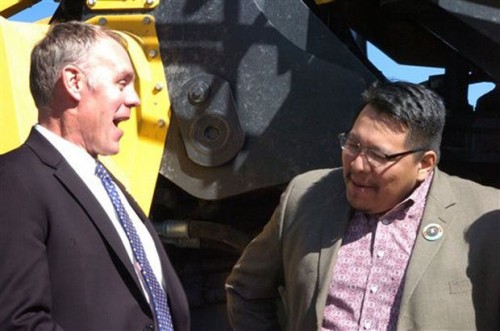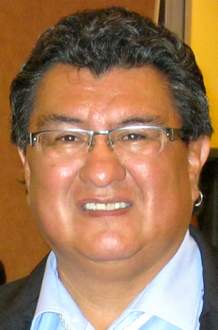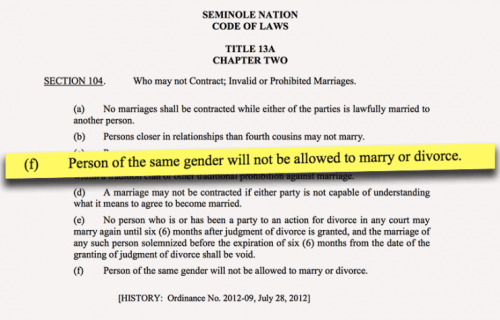After a 30-year struggle, the Pamunkey Indian tribe is first in Virginia to earn federal status
By Jackson McMillan, Tidewater Review
Acting Chief of the Pamunkey Indian tribe Robert Gray said the tribe has its work cut out navigating the new opportunities and programs the Pamunkey people are eligible for now that they are among the more than 500 tribal nations recognized by the federal government.
“The real challenge now is figuring out what our options are,” Gray said during a phone interview. “There are so many agencies and programs it’s like a smorgasbord of programs.”
On July 2, the federal government extended recognition to the Pamunkey Indian tribe, making it the first Virginia tribe to achieve such recognition.
In the wake of the announcement, former Pamunkey Indian Chief Kevin Brown, who has helped the tribe in its 30-year quest for such recognition, tendered his resignation as chief.
“It’s been a long hard road in getting the federal recognition, and I’m passing the torch to another member,” he said, adding that it is time for someone else to take up their own cause to advance the tribe.
Under Pamunkey law, Assistant Chief Gray will take over as acting chief and perform all of the duties of the chief. Gray said the Pamunkey will elect a new chief Aug. 6.
The tribe, which has 203 members, has proven that it meets seven mandatory criteria for federal recognition and will join the 566 other federally recognized tribal nations across the country. The process included collecting historical governing documents, tracing the lineage of tribe members and proving the tribe has lived as a distinct community with its own political influence since 1900, according to the Bureau of Indian Affairs.
“This work reflects the most solemn responsibilities of the United States,” said Kevin Washburn, assistant secretary of the Bureau of Indian Affairs in announcing the decision. “Our professional historians, anthropologists, and genealogists spent thousands of hours of staff time researching and applying our rigorous acknowledgment criteria to these petitions.”
Overcoming obstacles
The Pamunkey first applied for full federal recognition in 1982, Brown said.
Washburn’s decision was a defeat for numerous groups that had opposed the petition, including the Congressional Black Caucus as well as gaming and anti-gaming interests worried about the potential for the tribe to construct a gambling complex on the 1,200-acre Pamunkey reservation.
In January, several members of the Congressional Black Caucus voiced their opposition to federal recognition of the Pamunkey, asking Department of the Interior Secretary Sally Jewell and then-U.S. Attorney General Eric Holder to postpone the decision until the Justice Department investigated claims of discriminatory practices by the tribe.
The point of contention was in regard to an old tribal law that stated, “No member of the Pamunkey Indian Tribe shall intermarry with any (sic) Nation except White or Indian under penalty of forfeiting their rights in Town.”
Brown said the tribe repealed the law in 2012. “We hadn’t enforced that law in generations and did away with it before it got out.” According to Brown, the common rationale for the ban is that it was rooted in Virginia’s culture of racism, which, at the time, used racial intermixture as a means to deprive Native Americans of their ancestral lands.
The Association of American Convenience Stores also expressed fears that federally acknowledged tribes will result in competition for stores already located near reservations if a tribe decided to open a similar business on tribal lands, the reason being tribes would not have to charge taxes and a store could undercut prices.
Support for a historic tribe
But many historians and ethnologists have long argued that the descendants of the most powerful tribe to confront Capt. John Smith and the first English settlers at Jamestown deserved official federal status.
“The Pamunkey retained their original lands — their ancestral lands from the time before the English arrived — and they were the only group to do so. They’ve maintained their treaties with the government — treaties that go all the way back to the English and the 1600s,” said Buck Woodard, head of the American Indian Initiative at Colonial Williamsburg.
“If you want to know how important the Pamunkey and its leaders were — just look at how the English referred to them: They called them ‘The House of Pamunkey.’ And they’re still a special group today.”
Retired Virginia Department of Historic Resources archaeologist E. Randolph Turner II makes many of the same arguments, citing the tribe’s links to such historical figures as Powhatan, Opechancanough and Pocahontas.
Brown said Gov. Terry McAuliffe called him July 2 to personally congratulate the Pamunkey on their historic achievement.
In a statement issued by the Office of the Governor, McAuliffe lauded the decision.
“I want to congratulate members of the Pamunkey tribe on their tireless efforts to ensure that they receive the federal recognition that they deserve.” The governor’s statement also said he has supported federal recognition of the Pamunkey and recently sent a letter to the Bureau of Indian Affair backing their efforts.
McAuliffe said he hopes the Pamunkey tribe’s achievement will help enact the Thomasina E. Jordan Indian Tribes of Virginia Federal Recognition Act, a bipartisan bill that would grant federal recognition to the Chickahominy, Eastern Chickahominy, Upper Mattaponi — also located in King William County — Rappahannock, Monacan, and Nansemond Indian tribes. These tribes have been recognized by the state, but not the federal government.
In a joint statement, Virginia’s U.S. Sens. Mark Warner and Tim Kaine hailed the announcement by the Bureau of Indian Affairs. They are also cooperating on the Thomasina E. Jordan Indian Tribes of Virginia Federal Recognition Act.
“I congratulate the Pamunkey Indian Tribe on finally receiving this long-overdue federal recognition,” Warner said. “This historic milestone also reminds us of the work that remains before us to correct the injustices committed against Virginia Indian tribes. Senator Kaine and I will keep urging our colleagues in the Senate to pass our legislation to ensure that the Chickahominy Indian Tribe, the Chickahominy Indian Tribe-Eastern Division, the Upper Mattaponi Tribe, the Rappahannock Tribe, the Monacan Indian Nation, and the Nansemond Indian Tribe also get the federal recognition that they deserve.”
Members of the King William County Board of Supervisors also commended the Pamunkey on their recognition.
“I think it’s a great victory for the tribe, which made the first contact with British settlers 400 years ago, to finally have federal recognition,” said District 2 Supervisor Travis Moskalski.
Full federal recognition now allows Pamunkey tribal members to apply for a variety of programs, such as health and housing services, as well as educational and higher-learning opportunities.
Plans for the future
Brown said there is a 90-day waiting period before tribal members can begin benefiting from such programs, and it may be years before the Pamunkey are able to construct buildings they’re provided funding for, such as a health clinic. However, Brown said the Pamunkey are eligible to use facilities and services at the reservations of other federally recognized tribes.
Brown also quelled suspicions by many that the Pamunkey were planning to build a casino, which is permitted under full recognition.
“Look around,” Brown said gesturing to the line of trees and rows of crops that make up a sizable portion of land on the reservation. “There’s no place for a casino here.” Brown also said the Pamunkey hired a consultant to examine whether or not the reservation’s thoroughfares could handle the traffic a casino would undoubtedly bring. It was determined the investment from reconstructing roads and building a casino would not be feasible.
Gray said as much, saying the Pamunkey lack the infrastructure for a casino.
“We want to modernize, yes, but we’re country people and we like it that way,” Gray said. “For the long term we’re looking for options that benefit the tribe and allow us to be an independent sovereign nation. There’s a multitude of paths we can take but a casino is not one of them.”
“More than anything being recognized is historic vindication,” Brown said.
“Virginia tried to write us out, and this decision vindicates not only the Pamunkey, but every tribe that made up the Powhatan Confederacy. It gives our people legitimacy and it will benefit them down the road.”
When asked about the relevance of the decision coinciding with Independence Day, Brown chuckled.
“I hadn’t thought about that,” he said. “I guess maybe there’s a little bit of poetic justice there.”
McMillan can be reached by phone at 757-298-4136.
Pamunkey’s
30-year struggle
•1982: The Pamunkey Indian tribe applies for full federal recognition.
•2009: The Pamunkey file a letter of intent to petition the Bureau of Indian Affairs for federal recognition.
•August 2012: The BIA issues the Pamunkey “active consideration” for full recognition.
•January 2014: The Pamunkey earn preliminary federal recognition.
•January 2015: The Congressional Black Caucus asks the BIA to delay the decision and investigate the Pamunkey for discriminatory practices.
•March 2015: The BIA extends its deadline for a final determination on federal recognition of the Pamunkey.
•July 2, 2015: The Pamunkey become the first federally recognized tribe in the commonwealth of Virginia.
– See more at: http://www.tidewaterreview.com/news/va-tr-kw-pamunkey-0708-20150707-22,0,923109,full.story#sthash.Lsp8Jnwa.dpuf














